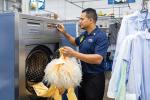CHICAGO — While piece counts may be down for many areas of the cleaning industry, the care of high-end couture clothing seems to be one that is gaining ground for many dry cleaners. But, what does it take to care for items that may be worth thousands of dollars?
In Part 1 of this series, we looked at the growth of this segment of the drycleaning industry, along with what sets couture clothing apart from other garments. Today, we’ll continue by exploring the mindset necessary to find success in this field.
Special Care for Special Items
Not only does cleaning couture cleaning take special care, it also takes a special mindset.
“How you do one thing is how you do everything,” says Jason Loeb, owner of the South Florida-based Sudsies Garment Care, which began caring for couture items more than 15 years ago. “Couture starts at the initial discussion with the guest. It’s not about cleaning it — it’s about educating the consumer (on the process and the care we take).”
Then, decisions have to be made on how best to proceed with the cleaning process.
“You have to decide what type of cleaning is best for the garment,” Loeb says. “Should it be hand-cleaned, wet-cleaned, dry-cleaned, or disassembled, with each part cleaned differently and then reassembled? There are four different types of cleaning methods that can be done, and that has to be determined by the experience of your team.”
Communication is key to a successful outcome, says Elizabeth Cayer, lead trainer at Oceanside Cleaners, headquartered in Jacksonville, Florida.
“We reach out to the customer to go over the process with them,” she says. “If we haven’t served them in the past, we do want to make them aware of the process we’re going to use, and ask for their approval before we proceed.”
After that, the work begins. “We then take it to our plant with our technicians,” Cayer says. “We only choose certain specialized technicians to work on these pieces — it’s not just going to just anybody — in order to get the proper care.”
While the garment is examined initially by the staff at the counter, who are trained to recognize these items, it’s then re-examined by the designer garment specialist.
“It gets an even more in-depth inspection, looking at it as closely as we possibly can for any potential damages, defects, stains and things of that nature,” Cayer says. “We want to make sure we’re taking care of the customer, and that means getting really good pre-qualification before we ever actually do any cleaning. We also take pictures of all the garments, with close-up pictures of specialty buttons or other embellishments. We want to make sure we really take a good look at those beforehand so we know what it should look like at the end.”
“At Sudsies, we teach couture methods first by identification of the different fabrics, design materials, construction of the materials, and the type of appointments on every piece of material,” Loeb says. “That means material could have gold buttons, for instance. We just did a pair of $5,000 pants that had gold-plated buttons. Do they have sequins? Do they have bugle beads? All these things have to be attended to differently. Everyone in our 250-member team is trained in couture. Again, the way it starts is the way it needs to finish.”
Cayer agrees that training is crucial when it comes to caring for valuable clothing.
“Only certain staff handle these garments,” she says, “so you have to make sure that you’re choosing the right kind of people to deal with these items.”
The people who are successful in this specialized market understand the nature of their mission.
“These are people who really pay attention to details and have an understanding of these garments and what they need to be taken care of properly,” she says. “They understand these garments are high value, that they’re made by hand. They understand the construction process of how these garments are made. They also know these couture garments cannot withstand the same cleaning as a more durable cotton pair of pants.”
Come back Tuesday for the conclusion of this series, where we’ll examine the process of cleaning couture clothing, and what the future may hold for this service. For Part 1 of this series, click HERE.
Have a question or comment? E-mail our editor Dave Davis at [email protected].






